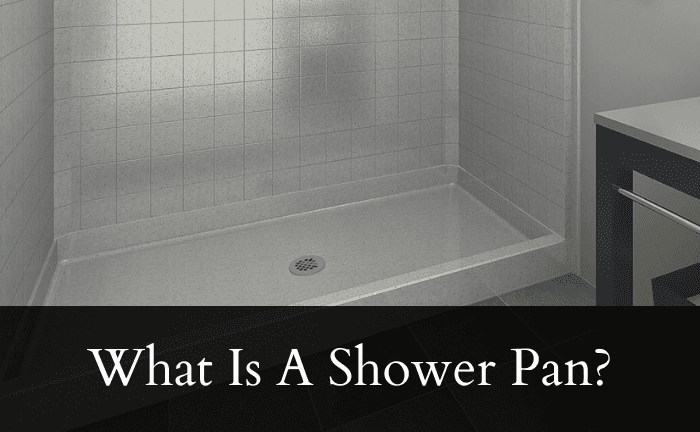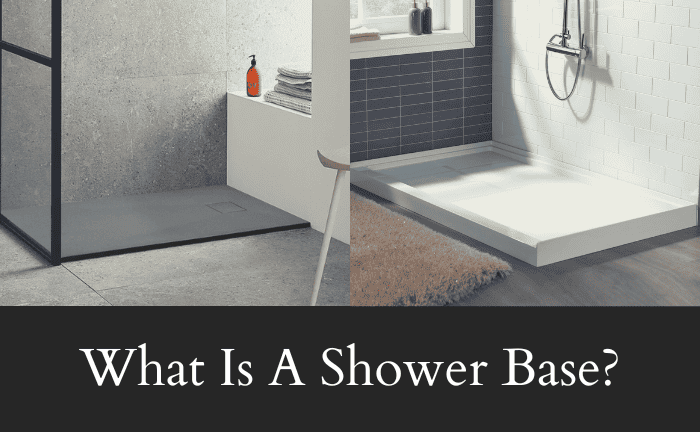If you’re planning a bathroom renovation or want to upgrade your shower, you may have come across the terms “shower pan” and “shower base.” While these terms are often used interchangeably, there are some critical differences between the two that are worth knowing before you make a purchase.
A shower pan and a shower base differ in the following perspectives.
- Construction
- Price
- Installation
In this writing, you’ll get to know everything about a shower pan and a shower base. So, without further ado, let’s get straight into it.
What Is A Shower Pan?

A shower pan is typically made of a single material, such as acrylic or fiberglass, and is designed to be installed directly onto the subfloor. It’s often used in situations where the subfloor is not level or where a custom size or shape is needed.
Shower pans come in various shapes and sizes, including rectangular, square, and neo-angle, and can be customized to fit your specific needs.
Pros
Here are the benefits of a shower pan.
1- Easy to Install
Shower pans are relatively easy to install. Single-piece structures can be set in place and secured to the subfloor. This makes them an excellent choice for DIY enthusiasts who want to establish showers.
2- Cost-Effective
Shower pans are typically less expensive than other shower base options. They are made of inexpensive materials such as acrylic or fiberglass, making them an excellent option for those on a budget.
3- Durable
Shower pans are durable and can withstand daily use. They are also resistant to mold and mildew growth, making them easy to clean and maintain.
4- Easy to Clean
Shower pans are easy to clean. Their smooth surface does not allow dirt and grime to build up, making them easy to wipe down with a damp cloth or sponge.
5- Customizable
Shower pans come in various sizes and shapes, making them customizable to fit any bathroom. They can also be tiled or finished with other materials to match the bathroom’s decor.
Cons
The disadvantages of a shower pan are given below.
1- Limited Material Options
Shower pans are typically made of acrylic or fiberglass, limiting the material options available. While these materials are durable, they may not provide the same aesthetic appeal as other options, such as stone or tile.
2- Limited Design Options
Shower pans come in limited design options, primarily standard sizes and shapes. Custom designs can be costly and time-consuming, making it challenging to achieve a unique look.
3- Prone to Cracking
While durable, shower pans can be prone to cracking over time, especially if not properly installed or maintained.
4- Limited Drainage Options
Shower pans have limited drainage options, which can lead to water buildup and potential mold or mildew growth.
5- Requires a Level Subfloor
Shower pans require a level subfloor for proper installation. If the subfloor is not level, it can lead to water buildup and potential damage to the shower pan.
What Is A Shower Base?

A shower base, on the other hand, is a pre-formed shower unit that is designed to be installed directly onto the subfloor. Unlike a shower pan, a shower base is typically made of several materials, including acrylic, fiberglass, or composite.
Shower bases are available in standard sizes and shapes, such as square or rectangular, and are often used in new construction or remodeling projects where the subfloor is level.
Pro
The windfalls of a shower base are given in the following.
1- Customizable
Shower bases come in a variety of sizes, shapes, and materials, making them customizable to fit any bathroom design. They can be tiled or finished with other materials to match the bathroom’s decor, providing endless design possibilities.
2- Durable
Shower bases are made of durable materials that can withstand daily use. They are less prone to cracks or leaks than shower pans, making them a longer-lasting option.
3- Aesthetic Appeal
Shower bases made of natural stone or tile provide a luxurious look and feel to any bathroom. They can add significant value to a home and improve the bathroom’s overall aesthetic appeal.
4- More Drainage Options
Shower bases offer more drainage options than shower pans, providing better water flow and preventing buildup. This helps to reduce the risk of mold or mildew growth, making it easier to maintain a clean and hygienic shower area.
5- Easy to Repair
If a tile or stone in the shower base gets damaged, it can be easily replaced. This allows for a quick and cost-effective repair rather than replacing the entire shower base.
Cons
Here are the drawbacks of shower bases.
1- Expensive
Shower bases made of natural stone or tile can be expensive, making them a costly option for those on a budget. The installation price can also be higher than that of a shower pan, requiring a more extensive installation.
2- More Difficult to Install
Shower bases require a more extensive installation process than shower pans. This involves laying a mortar bed and setting the tiles, which can be time-consuming and requires professional installation.
3- Prone to Scratches
Shower bases made of natural stone or tile are prone to scratches and stains, which can be challenging to remove. This can concern those who want to maintain a flawless appearance in their bathroom.
4- Heavy
Shower bases made of natural stone or tile can be heavy and require a sturdy subfloor. This can be a concern for older homes or homes with weak subfloors.
5- Maintenance
Shower bases made of natural stone or tile require regular maintenance to keep them clean and hygienic. This includes resealing the grout, preventing mold or mildew growth, and preventing scratches or stains.
What Are The Key Differences Between A Shower Pan And A Shower Base?
The main differences between a shower pan and a shower base are their construction, installation, and cost.
Construction
As mentioned, a shower pan is typically made of a single material, while a shower base comprises several pieces. Shower pans are usually made of less expensive materials such as acrylic or fiberglass, while shower bases are made of more durable and costly materials like stone or tile.
Installation
Shower pans are easier and faster to install than shower bases. Since they are made of a single piece, they must only be set in place and secured. Shower bases require more extensive installation procedures, such as laying a mortar bed and setting tiles, which can take longer.
Cost
The shower pan cost is generally lower than a shower base due to the materials used and the installation process. While shower bases can be more expensive, they can also add value to a home and last longer than shower pans.
Related: Do You Need A Shower Pan For A Walk-in Shower?
Final Verdict
In conclusion, a shower pan and base are waterproof barriers directing water to the drain. However, a shower pan is a single-piece structure that is easier and faster to install. In contrast, a shower base is typically made of more durable materials and requires a more extensive installation.
Knowing the difference between these two components is crucial when designing or remodeling a bathroom and can help you choose the right one for your needs and budget.
